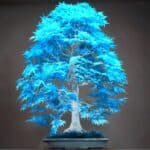Spanish moss is popular around the world but it was in the 19th century that its use was popularized in Hawaii as an ornamental and lei plant.
But can you use Spanish Moss for Kokedama? Yes, you can use Spanish moss for kokedama to add some life to your plants. Whether you are making kokedama as an ornament to place in your home, or you want to hang it from the walls, Spanish moss makes perfect sense for kokedama.


Nowadays Spanish moss is used for a variety of different things which includes as moss used for kokedama. Spanish moss has been used in evaporative coolers which are used in the southwestern United States to help keep the home cool.
Is Spanish Moss Good for Kokedama?
Spanish moss is an excellent choice for people who are making kokedama. It is perfect for plants growing indoors. Although not the most popular choice, it certainly has its benefit for your home environment. Whether you are making kokedama as an ornament to place in your home, or you want to hang your kokedama, Spanish moss makes perfect sense.

When you are making your kokedama you will need to use peat moss as part of the mixture. Spanish moss can’t be used for this. When you use Spanish moss, it should be used to wrap around the root of the houseplant. You will need to use twine to bind them together before inserting them into the soil ball itself.
You can also finish off the soil ball of your kokedama with Spanish moss by wrapping it around the soil ball and securing it with more twine. This will give your kokedama a distinctive look while it’s hanging from your wall. Kokedama can also be used as a decorative item in a bowl or on a shelf.
Spanish moss is good to have in the home as it is quite distinct looking. The moss is a light green and white color that hangs down from the basket. If you’re looking for an eye-popping feature for your home, Spanish moss is an excellent choice
Is Spanish Moss Easy to Care For?
As with any living thing you are introducing into your home, you need to know how to care for it properly and Spanish moss is no exception. Although it is not a demanding plant, it still requires water for its survival. The Spanish moss will be able to draw some of its food out of the soil but will also benefit from a spray of water every now and again.
Spanish moss does not have any roots to be able to absorb water and nutrients, unlike most other plants. The way Spanish moss absorbs water is through its stems which have trichomes along them. Trichomes are cupped scales that help the moss capture and hold water.

As the houseplant will rely on the moisture retained in its soil ball, your plant should have no problem thriving. Spanish moss will need a little bit more help as after the initial soaking the moss might not be able to keep feeding itself. This is easily solved by spraying the moss every so often to give a little more water on the stems.
One thing to look out for when you first bring Spanish moss home is a form of mite called Chiggers that can make their home in the moss. A Chigger bite can lead to red, itchy rashes breaking out on your body. To avoid this, it is advised to boil the moss before you start handling it, this should kill the chiggers.
What Other Kinds of Moss Can You Use for Kokedama?
There are several different types of mosses you can use with kokedama, although some are naturally better suited. Moss is part of the decorative features of kokedama and using a hanging moss like Spanish moss can really accentuate the art. When you are choosing which moss to use, you’ve got a few options available.
When you make your soil mixture, you will want to use a peat moss such as sphagnum as this is used as a soil conditioner. Sphagnum helps to increase the soil’s capacity for holding water and nutrients. That makes it particularly helpful for kokedama which can’t get frequent watering from the rain.

When it comes to what moss you use to wrap around the outside of the soil ball, the most common moss used is sheet moss. This is a type of carpet moss, which refers to the growth pattern the moss takes. Sheet moss form a large carpetlike mat on rocks or soil.
Other types of carpet moss that you could use are Thuidium, Ctenidum, Bryum, or Ceratodon. The kind of moss you see growing out of cracks in the sidewalk is a type of carpet moss.
What to Do If Your Moss Is Discoloring?
If you notice your moss start to discolor, no matter what kind of moss you have it’s better to be overly cautious than to let it continue. Moss will start to go brown if it is drying out or if it has been overwatered. Moss needs to be kept lightly moist at all times.
If this happens what you need to do is create a mini-greenhouse for your moss ball. Do this by putting the moss ball inside of a clear, thin bag, making sure to mist the bag before you do. Then keep the bag sealed to keep all of the moisture inside, place the bag in a medium-lit area to create a humid environment for the moss to thrive.
After 1-2 weeks, your moss should start to return to its normal coloring. If there is a puddle in the bag then the moss has been overwatered, so empty the bag and start again. If the coloring hasn’t returned, leave it in the bag for another week.























